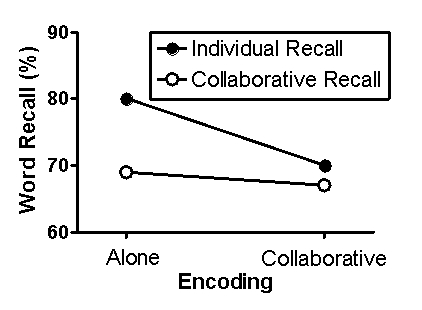Use the following to answer questions
Scenario I
Scenario I is based on and provides fabricated data consistent with the following study:
Barber,S.J. ,Rajaram,S. ,& Fox,E.B.(2012) .Learning and remembering with others: The key role of retrieval in shaping group recall and collective memory.Social Cognition,30(1) ,121-132.doi:10.1521/soco.2012.30.1.121
In a typical experiment on collaborative memory,participants first encode information individually and later attempt to recall the information either individually or in a small group (collaboratively) .While the recall of the collaborative group is better than that of any individual,the summed recall of individuals typically is better than the recall of the collaborative group.This is a phenomenon termed collaborative inhibition.Barber,Rajaram,and Fox (2012) investigated this phenomenon during both the encoding and retrieval stages of memory.
Participants created sentences out of a word bank,which provided for the opportunity to encode this information.After completing this task,participants engaged in an unrelated task-solving mazes-for 10 minutes.Then,in a surprise memory test,they were asked to recall as many words from the word bank as possible (retrieval) .
Participants were randomly assigned to one of four groups.In the first group (Alone-Alone) ,participants were studied individually during both the encoding and retrieval phases of the experiment.In the second group (Alone-Collaborative) ,participants were studied individually during the encoding phase and studied as part of a three-member team (triad) during the retrieval phase.In the third group (Collaborative-Alone) ,participants were studied in a triad during the encoding phase but individually during the retrieval phase.Finally,in the fourth group (Collaborative-Collaborative) ,participants completed both phases of the experiment as part of a triad.
Fabricated results illustrating the major finding of Barber et al.(2012) are presented in Figure 6.1.This figure shows the percentage of words from the word bank accurately recalled as a function of group.For the two groups that experienced the retrieval phase individually,scores represent the summed retrieval of the individuals comprising the group.For the two groups that experienced the retrieval phase as part of a triad,scores simply represent the collaborative performance.
Figure 6.1 
-(Scenario I) One possible explanation of collaborative inhibition is social loafing,or the established phenomenon that people do not exert as much effort on a task when studied as part of a group relative to when studied individually.A careful examination of the procedure and results,however,suggests that social loafing does not explain collaborative inhibition because:
Definitions:
Academic Achievement
The extent to which a student has attained their short or long-term educational goals, often measured by standardized tests or grades.
Homeless Children
Young individuals who lack a stable, permanent, and adequate nighttime residence, facing unique educational and social challenges.
Laundry Facilities
Services or locations that are equipped with washing machines and dryers for the purpose of cleaning clothes and linens.
State Identification
A process or document that officially recognizes an individual's identity by a governmental authority, typically through issuance of ID cards or certificates.
Q2: Fran's 4-year-old son awoke at 9:00 p.m.
Q4: (Scenario II)The mother is utilizing _ to
Q8: Troy's wife often observes him walking around
Q41: In a retrieval-induced forgetting paradigm,the _ actively
Q51: There are two types of explicit memory,_
Q77: Organizational encoding activates the upper portion of
Q180: Dolphins are MOST likely trained to do
Q227: Rescorla and Wagner theorized that a stimulus
Q270: _ memory refers to the gradual acquisition
Q270: Imagine that your girlfriend loves zydeco music.Eventually,your